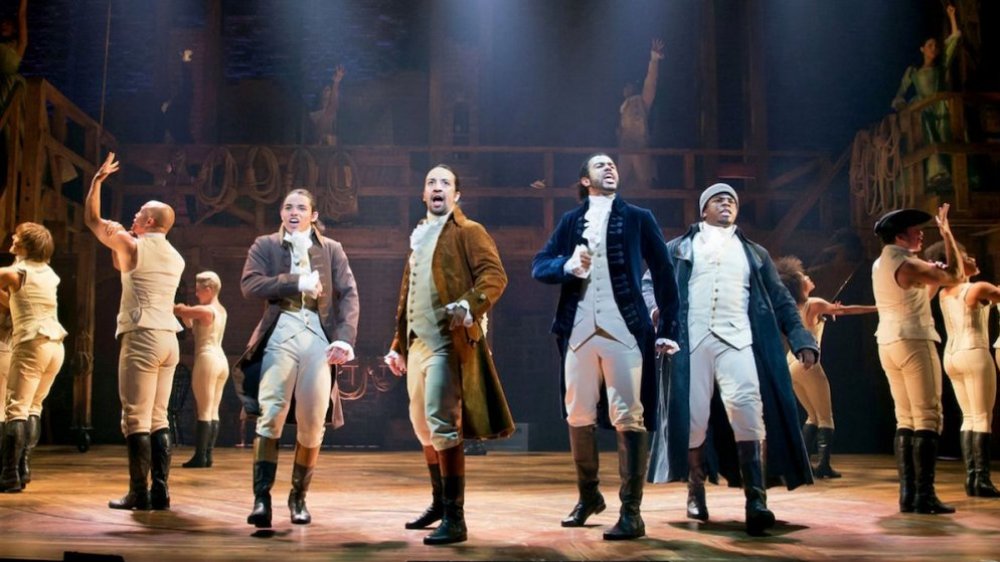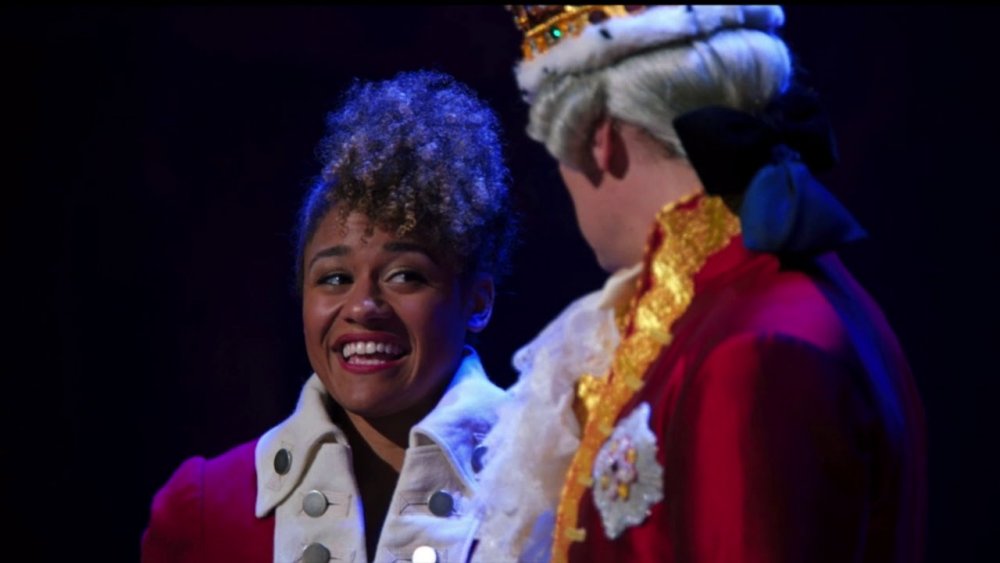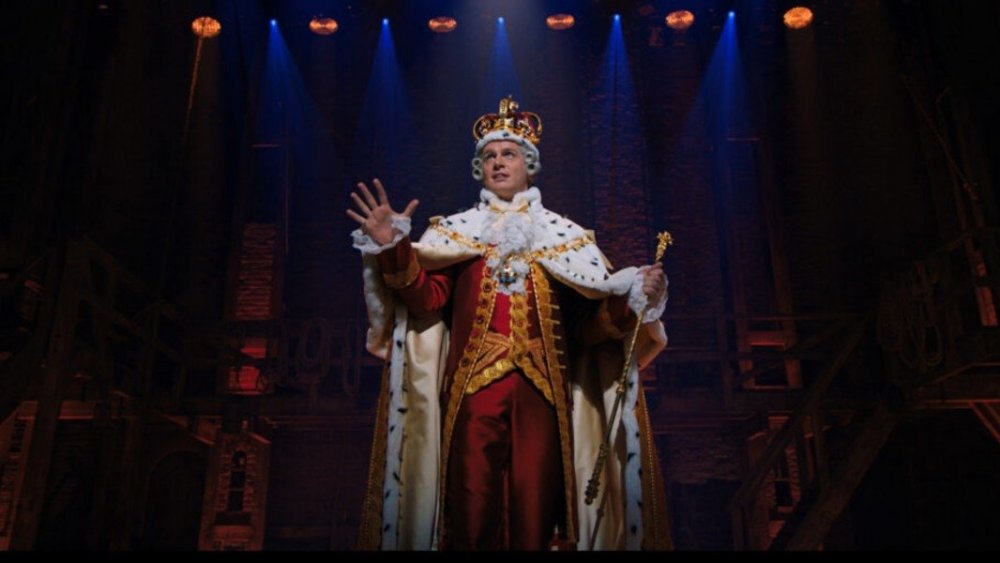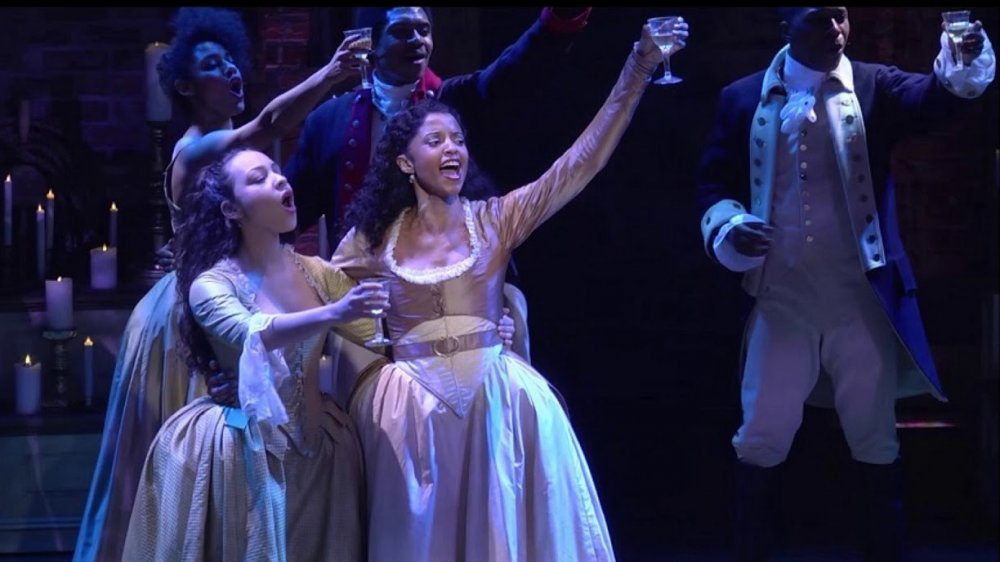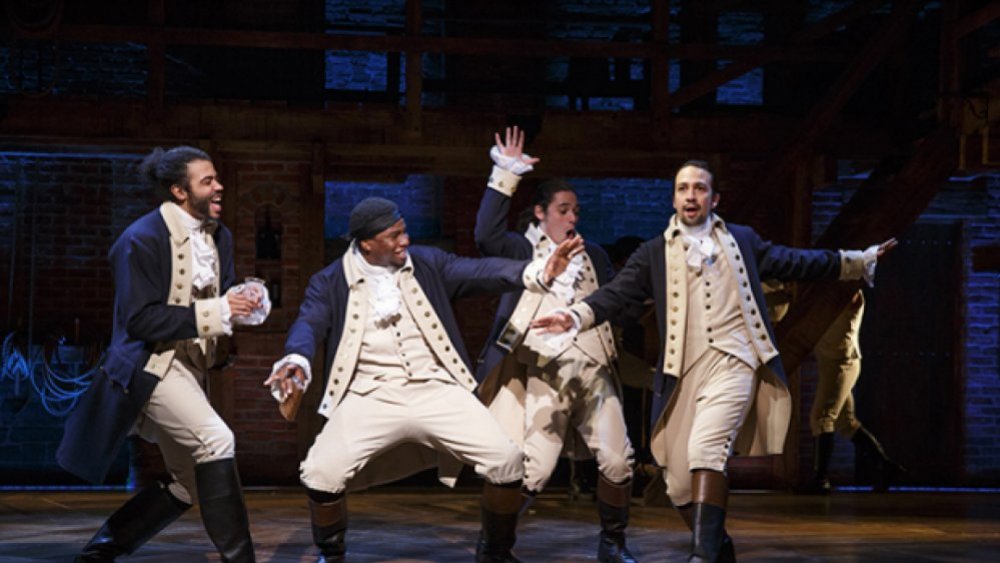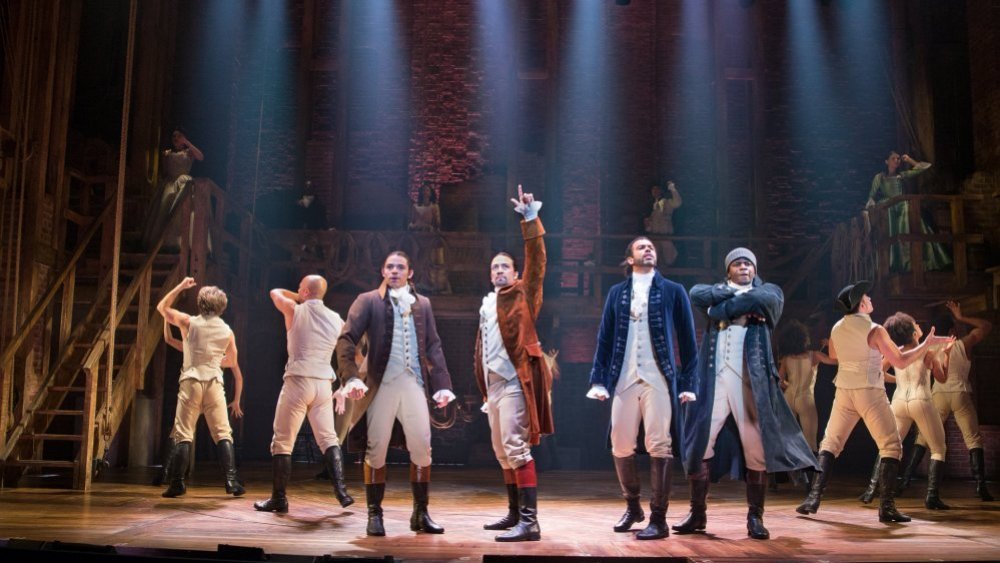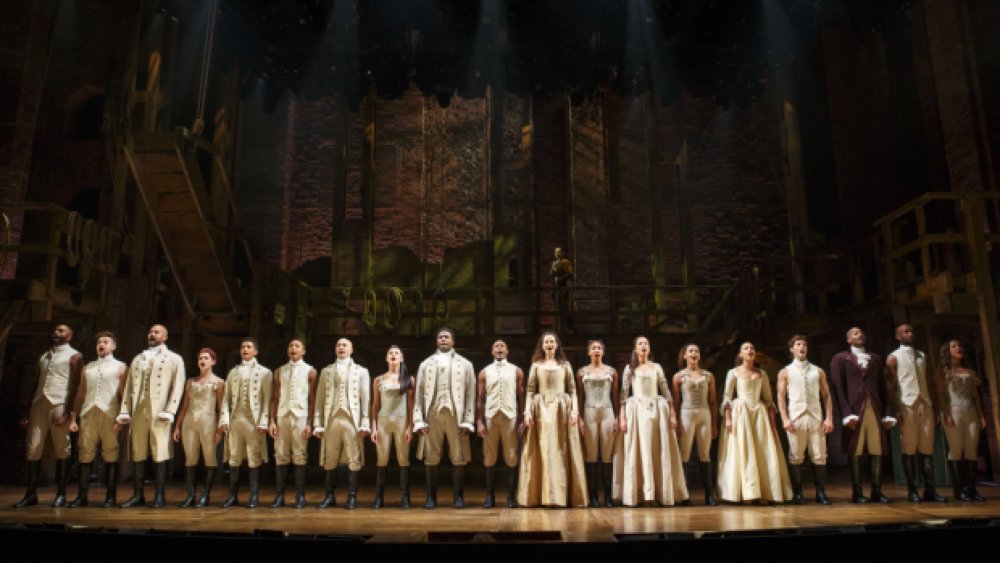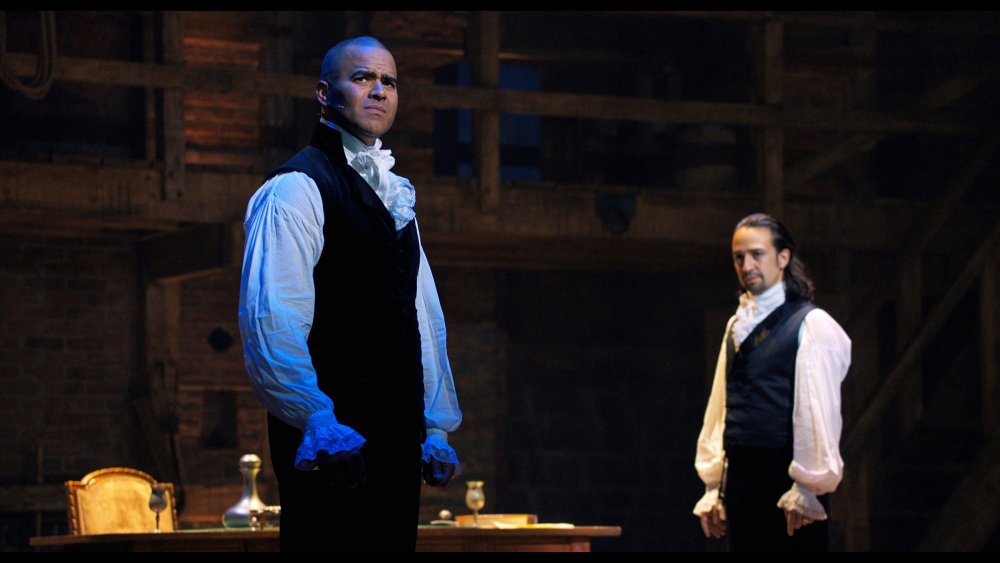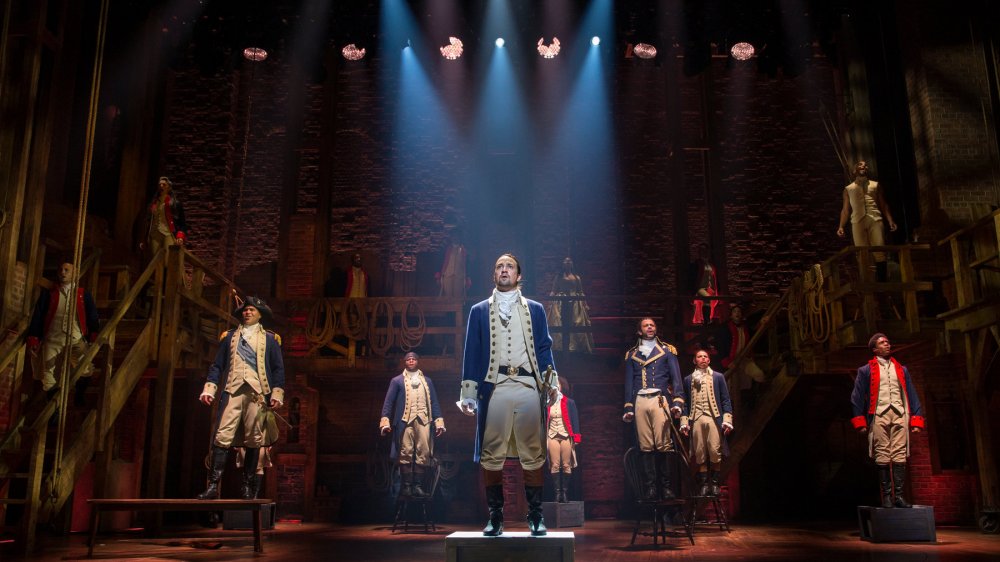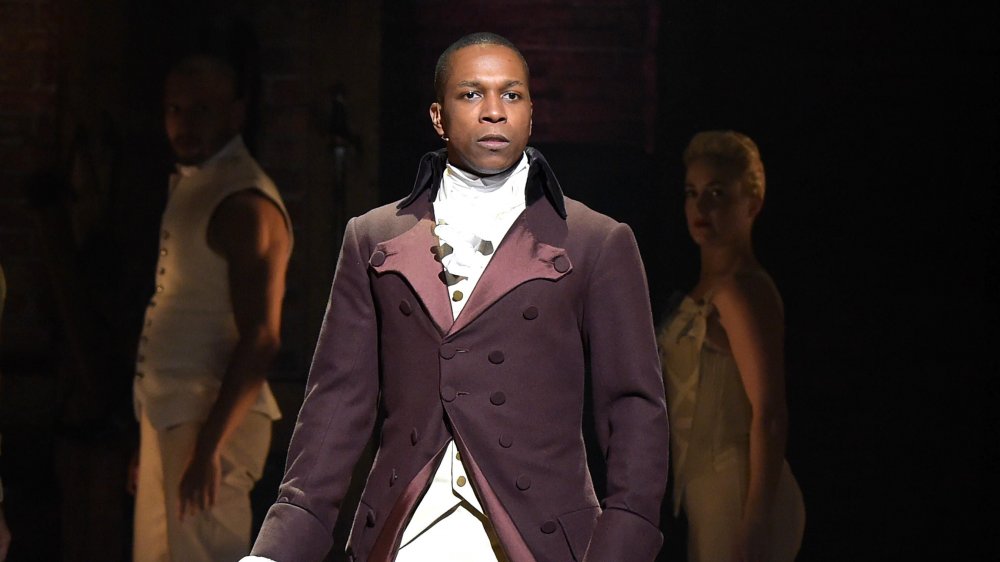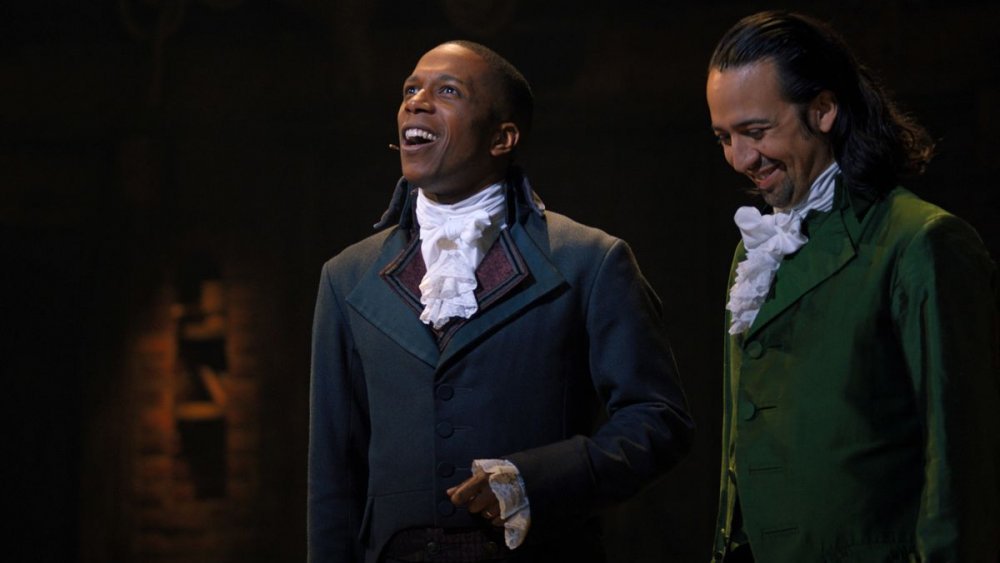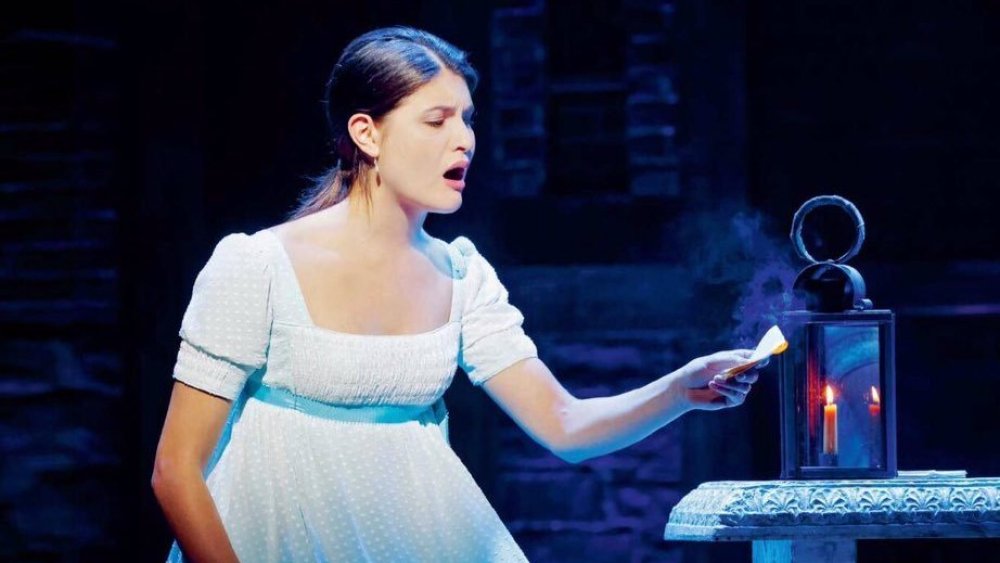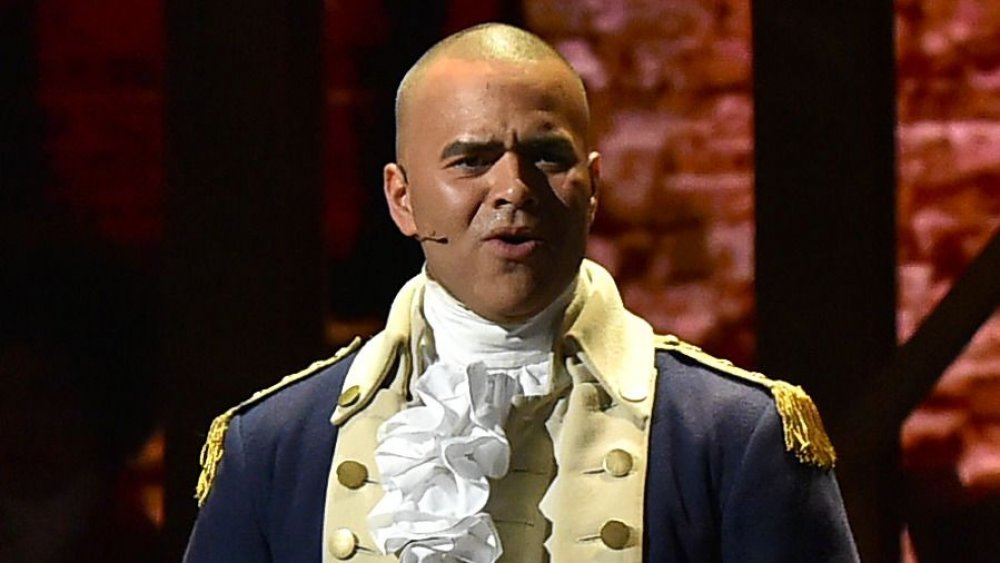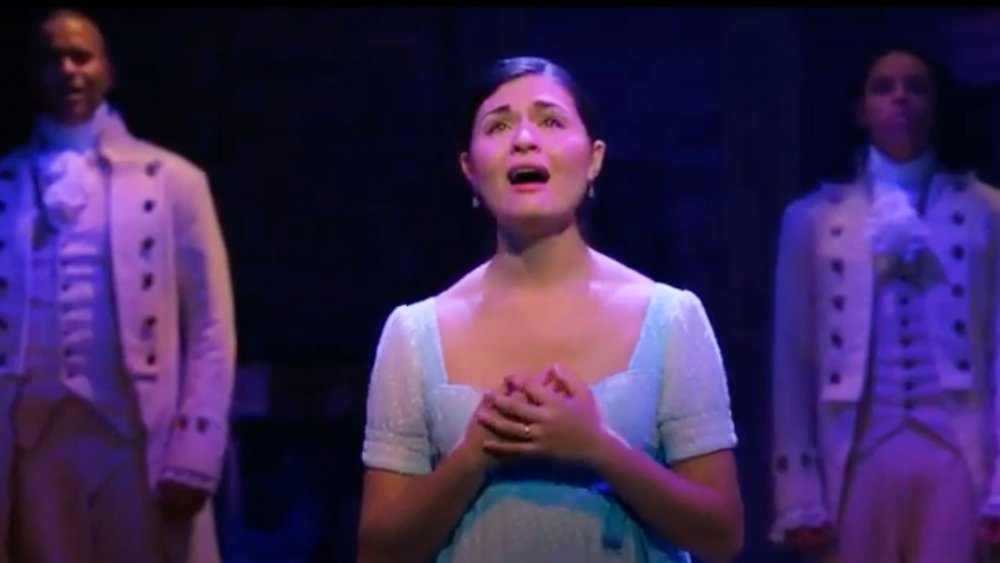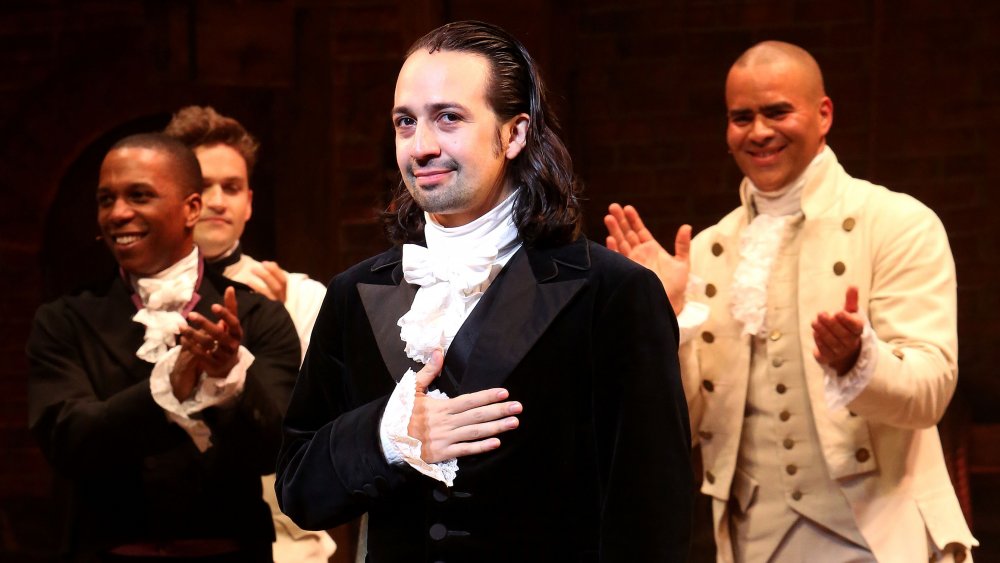Small Details You Missed In Hamilton
On July 3, 2020, Disney took the edge off the COVID-19 pandemic for millions of fans by releasing Hamilton onto its streaming platform months ahead of its originally planned theatrical release. Before this, Hamilton could only be enjoyed by those able to see it in person. If you weren't able to catch it on tour, didn't live near New York City, or are unable to afford the high-priced tickets, you were out of luck. In dropping it onto Disney+, Disney changed the game entirely.
Starring Miranda himself as Alexander Hamilton, the founding father previously best known for losing a duel to Aaron Burr (played in the musical by Leslie Odom Jr., who won a Grammy and a Tony for his performance), this filmed version of Hamilton features the entire original Broadway cast. It is brilliant — and extraordinarily dense. There are references to obscure American history, hip-hop shout-outs, and a whole lot of 250-year-old beef packed into this musical. Here are just some of the small details you probably didn't catch in Hamilton.
The Bullet and her connection to death
Throughout Hamilton, talented members of the ensemble can be seen helping change the set, providing backup for the leads, and in the case of the "The Bullet," providing important symbolism — though much of the audience doesn't even notice her. The Bullet, a role originated by Ariana DeBose, is the first person to die on stage. Take a look at the moments right after King George III's (Jonathan Groff) second song, "You'll Be Back:" The Bullet is the dancer executed for suspected espionage. From then on, she marks characters for death.
She is the last actor seen with John Laurens (Anthony Ramos) before he perishes in a gunfight. She later approaches Ramos once again, when he plays Hamilton's doomed son Philip, who also dies in a duel. All of The Bullet's background acting eventually builds to the duel between Burr and Hamilton, where The Bullet literally stands in for Burr's bullet heading towards Hamilton as he re-examines his life in the face of his now immediate demise. Next time you watch Hamilton, keep an eye out for The Bullet.
There's more to King George than meets the eye
One of the show's most popular and beloved characters is definitely King George III, who pops up several times to complain about and dismiss his not-so-loyal subjects. But he's more than meets the eye — though what meets the eye is indeed fabulous.
In his first song, "You'll Be Back," George enters slowly and dramatically, basking in the audience's reaction. As it turns out, this isn't just a moment of comic relief. According to star Jonathan Groff, King George's careful walk is mostly due to the fact that his costume is inordinately heavy. This makes sense: It has a heavy crown, an enormous ermine cape, and high heels, creating a kind of tightrope effect for the actor. Additionally, Groff, who originated the role on Broadway, was actually no longer with the show when the Disney feature was filmed. Kindly, Rory O'Malley, who was playing the role at the time, stepped aside to bring Groff back for a few shows. You'll also want to listen to King George's songs carefully, as they're peppered with historical references, including lines about how the King will eventually go "mad" and asides about the Boston Tea Party.
You may never be Satisfied
One of the musical's most stunning visual sequences is the transition from "Helpless," a love song sung by Eliza Schuyler (Phillippa Soo) to her future husband, into "Satisfied," a fast-paced, lovelorn number performed by Eliza's older sister, Angelica (Tony winner Renée Elise Goldsberry). Both of these songs are directed towards Alexander Hamilton. Though Angelica meets Hamilton first and an immediate connection emerges between the two, Angelica realizes Eliza loves him as well and retracts her interest. That doesn't mean her interest has disappeared, however, as she heart-wrenchingly details in "Satisfied."
By using the rotating stage to great effect, director Thomas Kail makes the audience feel as if they're directly inside of Angelica's considerable brain, which is swimming with indecision and regret. While the effect is remarkable in person, it's the rare effect that's even more impressive on-screen, thanks to Kail's quick and varied cuts that help the viewer feel as if time is rushing backward while Angelica recalls the events of "Helpless" from her own point of view. As Kail tells it, his direction was inspired by a very different Disney movie: "This is something I talk to the actors playing Angelica a lot — about Ratatouille. When the critic takes the bite, and you go into the critic's eye, that's what we're doing."
Three shows, one movie
Experiencing Hamilton would feel lacking if it hadn't been filmed during actual performances. Luckily, Kail and his team filmed shows throughout June 2016, shortly before Miranda and several other original cast members exited the production. While this means that audiences at home can enjoy the rapturous reactions to lines like "Immigrants: We get the job done," it's also an incredibly complicated process.
The Disney feature draws from three separate live performances, all of which took place shortly after the show won a whopping 11 Tony Awards. Kail also did some additional filming in an empty theater, making sure that extreme close-up shots of the performers — something most Broadway audience members don't even get to see — were perfectly captured to provide a truly panoramic view of Hamilton. In the end, the effect is seamless. If you didn't know any better, you'd guess it's just one show, filmed from beginning to end.
One of the wordiest musicals ever
One of the most remarkable things about Hamilton is just how much Miranda managed to pack into a show that runs just over two and a half hours long. If you've ever listened to Hamilton, it should come as no surprise that the show's word count is extraordinarily high: Hamilton contains an astounding 20,520 words, with an average of 144 words per minute. In contrast, other famous musicals like The Phantom of the Opera only contain 6,789 words at a rate of 68 words per minute. On top of that, if it were performed at the speed of a typical Broadway musical, Hamilton would last anywhere from four to six hours.
A key factor keeping Hamilton's pace firmly on track is Daveed Diggs, a rapper and actor who plays the dual role of Marquis de Lafayette in the first act and Thomas Jefferson in the second act. During the first act, in his show-stopping number "Guns and Ships," Diggs raps an incredible 6.3 words a second, the fastest lyrical run in Broadway history. In fact, Miranda ended up adding an entire second section to "Guns and Ships" after casting Diggs and realizing the true depth of his talent. This certainly worked out for Diggs, who won a Tony Award for his jaw-dropping performance.
The musical cues tell their own stories
As with any musical, several lines and motifs recur throughout the show. Consider Hamilton's refrain, in which he imagines death "so much, it feels more like a memory," to George Washington's (Christopher Jackson) warning, that you have no control over "who lives, who dies, who tells your story." However, much of the music itself tells a complex story, without many audience members ever even noticing.
One example is the opening number, "Alexander Hamilton," which features the entire cast singing about Hamilton's tragic childhood and his journey from the Caribbean to New York City. After Hamilton's father leaves and his mother dies, he writes his way out of destitution, using his enormous intelligence as his salvation. As Hamilton realizes that he can use his brains as a pathway to a better life, the music's pace picks up noticeably. The pace similarly picks up when he meets the Schuyler sisters, who will also propel him to success, albeit in a very different way. Another example comes from Angelica Schuyler, who revisits a musical refrain from "Satisfied" in "The Reynolds Pamphlet" with brutal ironic force. In "Satisfied," she longs fruitlessly for Hamilton, but in "The Reynolds Pamphlet," she is putting "what [they] had aside" to support her sister, who has been publicly humiliated by Hamilton's affair. Using the same melody hammers her message home: She stands beside her sister, despite the love she had for him. That's how angry she is.
Constant musical references
As a musical based in rap and hip hop, Hamilton sets itself apart from most Broadway productions. But it's not just using rap as set dressing: Hamilton is packed with references to the history of the genre. For example, in "My Shot," Hamilton references both Mobb Deep and Notorious B.I.G., just to name a few, and Miranda has said that different rappers influence different characters. Eminem was a huge influence on Hamilton himself, while George Washington raps in the style of Common with the singing voice of John Legend.
Broadway nerds have just as many references to spot in Hamilton. In George Washington's introduction, "Right Hand Man," he calls himself "the very model of a modern major general" in reference to The Pirates of Penzance, while Aaron Burr quotes South Pacific in "Aaron Burr, Sir." Perhaps the most obvious allusion, which isn't so much a reference as a direct quote, is the closing line of "Say No to This," which details Hamilton's marital infidelity. Miranda quotes Jason Robert Brown's The Last Five Years with the line "nobody needs to know," a quote used with Brown's blessing.
The set itself is full of visual cues
Hamilton uses a relatively simple set, mostly consisting of a few chairs, tables, and boards, as well as a catwalk and a revolving stage. But that doesn't mean consideration and care hasn't gone into every single element on stage.
The raw brick walls behind the performers — which is actually printed fabric — is supposed to present a half-finished feel, representing the novelty of America itself during and after the Revolutionary War. It's also filled with ropes and mobile staircases, which are nautical touches that reference the journey of America's immigrants. As for those three rotating circles in the middle of the stage, Kail wanted them to represent the "whirlwind of history." The way it moves is important: Counterclockwise tells the audience that time has passed, while a clockwise turn suggests "resistance" to whatever events are happening in the narrative.
Take care to keep your eye on the catwalk and you'll notice characters like Angelica, Lafayette, and Madison are almost always present, even when their character isn't directly involved in the number itself. These little touches help make the show feel even more complete, and hammer home the fact that history impacts everyone, even those in the "background" of the story being told. Thanks to the film, they're easier to spot than ever.
A small prayer during one of the show's most emotional numbers
In "Dear Theodosia," the second to last song in Hamilton's explosive first act, both Burr and Hamilton take a breather after winning the Revolutionary War. They've both become fathers, and "Dear Theodosia" is a song to their eldest children — Burr's daughter, Theodosia, and Hamilton's son, Philip. This incredibly touching song sees both fathers, who didn't have father figures in their lives growing up, promising to always be there for their children. They are flooded with the realization that Theodosia and Philip will grow up alongside their nation, and hope that both will "blow us all away [...] someday."
As it turns out, Leslie Odom Jr. added a very personal touch to "Dear Theodosia" during his tenure in Hamilton. Every time he sang the song, he added a small prayer, head bowed, for his daughter Lucille Ruby, who was born on April 23, 2017. Before his daughter even came into the world, Odom Jr. had already said over 500 prayers for her.
The vast differences between Burr and Hamilton
Throughout Hamilton, Burr and Hamilton occupy very different roles in each others' lives. Sometimes the two are friends, other times they're political rivals, and ultimately, they become enemies. In many ways, they couldn't be more similar — but in the end, it is their devastating differences that change their lives forever. Those differences (and how they affect the two men's fortunes) consume Burr throughout songs like "Wait For It," "Non-Stop," and "My Obedient Servant."
Kail and Miranda express the innate differences between Hamilton and Burr in a wide variety of physical and musical ways. From a physical perspective, Burr moves in straight lines, which indicates his adherence to the status quo, while Hamilton moves in arcs, which shows that he's willing to break with tradition to achieve his goals. Moreover, Burr is usually slightly behind the pace of the music and Hamilton is typically ahead of it, furthering the narrative that Hamilton is always a few steps ahead of his rival — that is, until the bitter end.
Eliza's letters aren't just simple props
It should be obvious, as you watch Hamilton, that Kail and Miranda didn't do anything by halves. Hamilton's love letters to his wife Eliza are no exception. As Eliza details in "Helpless," Hamilton writes her dozens of love letters until she falls in love with him as well, which she packs into a trunk, aided by her sisters. However, later on, Hamilton's penchant for the written word causes a rift between him and Eliza when he pens "The Reynolds Pamphlet," detailing his marital infidelity with Mariah Reynolds to clear his name regarding a potential financial scandal. Eliza doesn't just have to deal with being cheated on — she has to deal with it being a public scandal, orchestrated by her husband.
Eliza grapples with this awful information in "Burn," a second-act ballad that finds her torching her husband's many love letters in revenge. As Eliza burns each letter, keep a close eye on the props: They're actual transcriptions of the real letters Alexander Hamilton once sent to his wife. Also, the paper they're written on is a special kind that burns extra quickly, allowing Phillippa Soo to burn multiple pages during the song for dramatic effect.
Christopher Jackson's nod to George Washington's greatest flaw
After Burr fatefully and fatally shoots Hamilton in the duel that serves as the show's climax, the show launches into its final emotional number: "Who Lives, Who Dies, Who Tells Your Story." As each character remembers Hamilton's life and ponders what he could have accomplished if he had lived even just a little bit longer, one of the actors includes a small gesture to the first President's inaction on one of America's most horrifying atrocities.
Considering Hamilton features actors of color as the founding fathers, it's no surprise that the show has stoked several arguments about its treatment of slavery. Christopher Jackson, George Washington's original actor, acknowledges the issue in a unique way: When Eliza says that, in her husband's absence, she "spoke out against slavery," Jackson nods regretfully, referencing the fact that Washington not only did nothing to rid America of slavery, but was a slaveowner himself. It's just one way the show grapples with a complicated portrayal of America's first Commander-in-Chief.
The gasp heard 'round the world
If you'd only listened to the Hamilton cast album before watching the film on Disney+, there are only a few moments you missed. One of them happens right at the end of the show ... and is fascinatingly ambiguous. As Eliza, who lived 50 years longer than her husband, details her attempts to celebrate Hamilton's life in the wake of his untimely death, she lists her accomplishments. They are many, including founding New York City's first private orphanage, helping to build the Washington Monument, and assembling Hamilton's "thousands of pages of writing." As the number draws to a close, Hamilton, who is silent throughout the number, walks forward to meet his wife. As he brings her toward the audience, Eliza looks out, shocked, and lets out a loud, emotionally charged gasp.
Ever since Hamilton hit Broadway in 2015, fans have argued about what this moment could possibly mean. Some believe it represents her shock at seeing her husband again, or perhaps her surprise upon reaching the afterlife. Many, however, believe it to be, in Soo's own words, a moment of "transcendence," in which Eliza sees the audience, and grasps the immensity of the fact that her story lives on. That interpretation, with its focus on history-as-story, is particularly popular, especially as it invites complexity: Eliza might be touched people remember her, but also shocked to see a country reckoning with her generation's failures.
Keep an eye on the special thanks section
If you stick around through Hamilton's credits sequence, you'll get to hear some numbers from the show remixed and reworked by famous fans like The Roots. That's fun enough, but you'll also get a glimpse into Lin-Manuel Miranda's long and incredibly involved writing process if you pay close attention to the "special thanks" section.
If you pause during this section, you might notice several locations listed. This seems odd, until you realize those locations are the very places Miranda wrote Hamilton, from Hamilton's original home of Nevis to New York City's A train to the Dominican Republic, where he penned "Dear Theodosia." It took years for Hamilton to come together — now, Miranda thanks the places that inspired him in creating this stunning masterpiece. The sheer breadth of places is impressive, but really, with a musical as heterogeneous as Hamilton, would you expect anything less?
